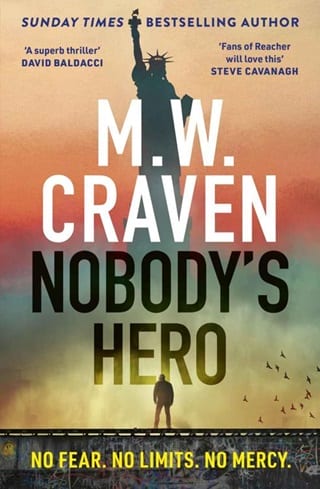Chapter 3
The cold-blooded murder of two Romanian nationals was the lead in every British newspaper for days. That a homeless woman had committed the murder triggered emergency debates on housing and mental health. That she'd used a gun in a city more used to knife crime caused the mayor's approval rating to drop by ten points. That the homeless woman had subsequently abducted a retired academic and seemingly vanished meant the Metropolitan Police commissioner, the UK's senior police officer, was called to the Home Office for a chat without coffee.
The senior investigating officer in the Speakers' Corner murders was called Detective Chief Superintendent Danielle Brown. Her first task had been to send a team to the basement dwellers who monitored the city's CCTV cameras. London was one of the most surveilled cities on the planet. Despite that, her team had found nothing. A portal to a billion snatches of London life and not one workable lead. On the rare occasion the homeless woman had been captured on tape, she was still hooded and wearing the surgical mask. Danielle had cursed the pandemic that had made it acceptable for criminals to wear what were essentially Dick Turpin masks in broad daylight.
She gave up on CCTV and resorted to old-school policing: leaning on snitches and knocking on doors.
But deep underneath the streets and the sewage drains and the high-end restaurants was a basement dweller who hadn't given up. He was called Graham Hancox, and from his swivel seat he could access all of Westminster Council's static and mobile CCTV cameras. He'd taken it as a personal insult that the homeless woman had managed to evade him. Because Graham was exactly the kind of person who believed a multimillion-pound surveillance system belonged to him. In his spare time Graham trawled the streets of London, looking for private cameras the police might have missed. Doorbell cams, nanny cams, dash cams, shop security systems. When he found one, he had the raw footage sent to his work email.
So far, he had found nothing.
But that was about to change.
The paused footage on Graham's screen was of the homeless woman and Margaret Wexmore. The homeless woman was gripping Margaret's arm and dragging her along one of the few suburban streets that wasn't covered by CCTV.
‘Where did you get this?'
Graham explained that the owners of a Greek deli had aimed a private CCTV camera at the cash register near the door, and because the gyros meat was cooking, the door had been wedged open to let in some air.
Danielle was disappointed. All the footage showed was the homeless woman in a different part of London. It added to what they knew of the journey she'd taken, but it didn't contribute to the wider story of who she was, or where she and Margaret Wexmore were now.
Graham saw her expression. He said, ‘Watch this.'
He pressed play. Instead of walking out of shot, the homeless woman removed a fob from her pocket. She used it to unlock a Volkswagen Golf. She opened the passenger door for Margaret and helped her inside. She then walked to the driver's side and opened the door.
But before she got in, she took off her coat and removed her mask.
Three weeks after the Romanian pickpockets were shot in the back of their heads, Detective Chief Superintendent Danielle Brown finally saw the face of the woman who'd pulled the trigger. Graham took a screenshot and Danielle rushed it through the Metropolitan Police's facial-recognition program.
One hour later, the case was shut down.
Several things happened in that hour.
The first was the facial-recognition program returning a negative result. The homeless woman wasn't in the system. The second thing that happened was that a silent alert was triggered. It automatically sent an eyes-only email to the cultural attaché at the US embassy in Nine Elms, the biggest American embassy in western Europe. The cultural attaché, a CIA veteran called Bernice Kopitz, opened the email, read it twice, then followed the instructions exactly. She called a number in Virginia, and when it was answered, she said ‘Acacia Avenue'. Bernice didn't know what that meant, and she knew she never would. She deleted the email she'd been sent and cleared it from her trash. She then went back to work and forgot all about it.
They didn't forget all about it in Virginia. ‘Acacia Avenue' was passed up the chain of command until it found the one person with the right security clearance. That person used an eleven-digit code to open a safe in his office. It was only the second time it had been opened. The first was shortly after it had been installed. The man opening the safe now had no idea what was inside. He only knew that if the phrase ‘Acacia Avenue' was passed up the chain of command, he was to open the safe and follow the instructions he would find inside.
Inside the safe was a sealed envelope. He opened it and removed the single sheet of paper. It was a list of names. A list of names and a single sentence. It said he was to contact the person at the top of the list and tell them the Acacia Avenue Protocol had been initiated. If that person couldn't be contacted, he was to go on to the second name.
The list had four names. He recognised the first three. Knew them personally. He also knew they were dead. The big three: cancer, a stroke, and an old-fashioned heart attack. He'd gone to their funerals.
He didn't know the fourth name on the list, though.
He typed it into his computer. A single result came back. He frowned. It didn't make sense. The first three names had been serious people with serious jobs. The fourth name was a nobody. He pressed the intercom on his desk and summoned his aide.
The aide, an air force captain, was there immediately.
‘Sir?'
‘I need you to find someone for me.'
‘Who, sir?'
The man told him.
‘Who the hell is Ben Koenig?' the aide said.
 Fullepub
Fullepub 



